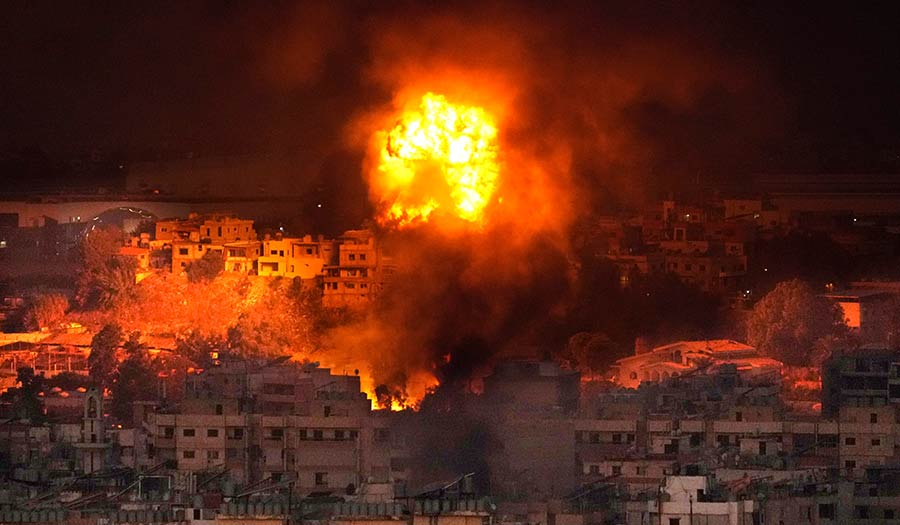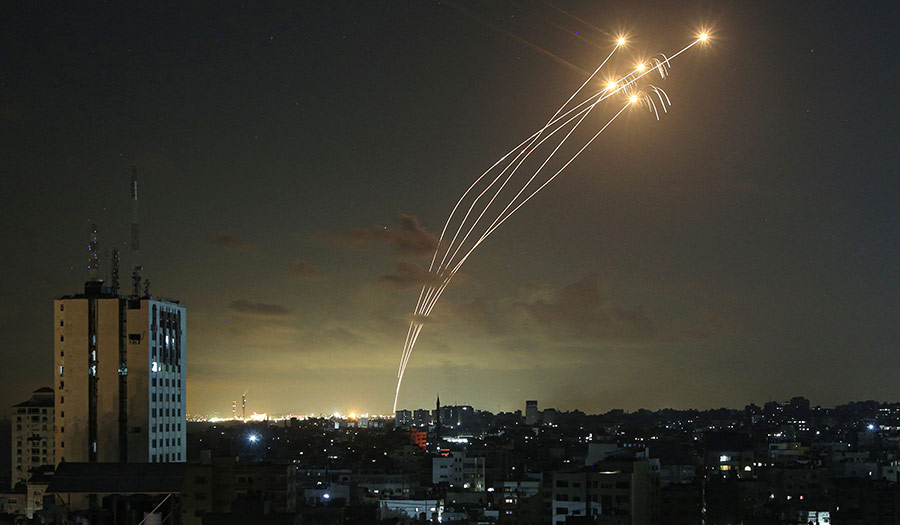 AP/Hussein Malla
AP/Hussein Malla
Article
Learn the why behind the headlines.
Subscribe to the Real Truth for FREE news and analysis.
Subscribe NowJERUSALEM (AP) – A year after Hamas’ fateful attack on southern Israel, the Middle East is embroiled in a war that shows no signs of ending and seems to be getting worse.
Israel’s retaliatory offensive was initially centered on the Gaza Strip. But the focus has shifted in recent weeks to Lebanon, where airstrikes have given way to a fast-expanding ground incursion against Hezbollah militants who have fired rockets into Israel since the Gaza war began.
Next in Israel’s crosshairs is archenemy Iran, which supports Hamas, Hezbollah and other anti-Israel militants in the region. After withstanding a massive barrage of missiles from Iran last week, Israel has promised to respond. The escalating conflict risks drawing deeper involvement by the U.S., as well as Iran-backed militants in Syria, Iraq and Yemen.
When Hamas launched its attack on October 7, 2023, it called on the Arab world to join it in a concerted campaign against Israel. While the fighting has indeed spread, Hamas and its allies have paid a heavy price.
The group’s army has been decimated, its Gaza stronghold has been reduced to a cauldron of death, destruction and misery and the top leaders of Hamas and Hezbollah have been killed in audacious attacks.
Although Israel appears to be gaining the edge militarily, the war has been problematic for Prime Minister Benjamin Netanyahu, too.
Dozens of Israeli hostages are languishing in Hamas captivity, and a year after Mr. Netanyahu pledged to crush the group in “total victory,” remnants of the militant group are still battling in pockets of Gaza. The offensive in Lebanon, initially described as “limited,” grows by the day. A full-on collision with Iran is a possibility.
At home, Mr. Netanyahu faces mass protests over his inability to bring home the hostages, and to many, he will be remembered as the man who led Israel into its darkest moment. Relations with the U.S. and other allies are strained. The economy is deteriorating.
Here are five takeaways from a yearlong war that has upended longstanding assumptions and turned conventional wisdom on its head.
A Region Is Torn Apart by Unthinkable Death and Destruction
A long list of previously unthinkable events have occurred in mind-boggling fashion.
The October 7 attack was the bloodiest in Israel’s history. Young partygoers were gunned down. Cowering families were killed in their homes. In all, about 1,200 people died and 250 were taken hostage. Some Israelis were raped or sexually assaulted.
The ensuing war in Gaza has been the longest, deadliest and most destructive in the Israeli-Palestinian conflict. Gaza health authorities say nearly 42,000 people have been killed—roughly 2 percent of the territory’s entire population. Although they do not give a breakdown between civilians and combatants, more than half of the dead have been women and children. Numerous top Hamas officials have been killed.
The damage and displacement in Gaza have reached unseen levels. Hospitals, schools and mosques—once thought to be insulated from violence—have repeatedly been targeted by Israel or caught in the crossfire. Scores of journalists and health workers have been killed, many of them while working in the line of duty.
Months of simmering tensions along Israel’s northern border recently boiled over into war.
A growing list of Hezbollah officials—including the group’s longtime leader—have been killed by Israel. Hundreds of Hezbollah members were killed or maimed in explosions of pagers and walkie-talkies. Israel’s ground offensive is its first in Lebanon since a monthlong war in 2006.
Fighting between Israel and Hezbollah has displaced tens of thousands of Israelis and over 1 million Lebanese. Israel promises to keep pounding Hezbollah until its residents can return to homes near the Lebanese border; Hezbollah says it will keep firing rockets into Israel until there is a cease-fire in Gaza.
The Leaders of Hamas and Israel Appear in No Rush for a Cease-fire
When the war erupted, the days appeared to be numbered for both Mr. Netanyahu and Hamas leader Yahya Sinwar.
Mr. Netanyahu’s public standing plummeted as he faced calls to step aside. Mr. Sinwar fled into Gaza’s labyrinth of tunnels as Israel declared him a “dead man walking.”
Yet both men—facing war crimes charges in international courts—remain firmly in charge, and neither appears to be in a rush for a cease-fire.
The end of the war could mean the end of Mr. Netanyahu’s government, which is dominated by hard-line partners opposed to a cease-fire. That would mean early elections, potentially pushing him into the opposition while he stands trial on corruption charges. Also looming is the prospect of an unflattering official inquiry into his government’s failures before and during the October 7 attack.
Fearing that, his coalition has hung together even through mass protests and repeated disagreements with top security officials pushing for a deal to bring home the hostages. After a brief period of post-October 7 national unity, Israel has returned to its divided self—torn between Mr. Netanyahu’s religious, conservative, nationalist right-wing base and his more secular, middle-class opposition.
Mr. Sinwar, believed to be hiding in Gaza’s tunnels, continues to drive a hard bargain in hopes of declaring some sort of victory. His demands for a full Israeli withdrawal, a lasting cease-fire and the release of a large number of Palestinian prisoners in exchange for scores of hostages have been rejected by Israel—even as much of the international community has embraced them.
With cease-fire efforts deadlocked and Mr. Netanyahu’s far-right coalition firmly intact, the war could go on for some time. An estimated 1.9 million Palestinians remain displaced in Gaza while an estimated 68 hostages remain captive in Gaza, in addition to the bodies of 33 others held by Hamas.
Bitter Enemies Experience the Limits of Force
Early in the war, Mr. Netanyahu promised to destroy Hamas’ military and governing abilities.
Those goals have been achieved in many ways. Israel says it has dismantled Hamas’ military structure, and its rocket barrages have been diminished to a trickle. With Israeli troops stationed indefinitely in Gaza, it is difficult to see how the group could return to governing the territory or pose a serious threat.
But in other ways, total victory is impossible. Despite Israel’s overwhelming force, Hamas units have repeatedly regrouped to stage guerrilla-style ambushes from areas where Israel has withdrawn.
Across the Middle East, bitter enemies are witnessing the limits of force and deterrence.
Israel’s deepening invasion of Lebanon and repeated strikes on Hezbollah have failed to halt the rockets and missiles. Missile and drone attacks by Iran and its allies have only deepened Israel’s resolve. Israel is vowing to strike Iran hard after its latest missile barrage, raising the likelihood of a broader, regionwide war.
Without diplomatic solutions, the fighting is likely to persist.
Israel and Gaza Will Never Be the Same
Israel is still deeply traumatized as people try to come to terms with the worst day in its history.
The October 7 killings and kidnappings had an outsized impact on a tiny country founded in the aftermath of the Holocaust. Israelis’ sense of security was shattered, and their faith in the military was tested like never before.
Photos of Israeli hostages are everywhere, and mass demonstrations are held each week calling on the government to reach a deal to bring them home. The prospect of ongoing war looms over families and workplaces as reserve soldiers brace for repeated tours of duty.
The trauma is far more acute in Gaza—where an estimated 90 percent of the population remains displaced, many of them living in squalid tent camps.
The scenes have drawn comparisons to what the Palestinians call the Nakba, or catastrophe—the mass displacement of hundreds of thousands of Palestinians during the war surrounding Israel’s creation in 1948. The Palestinians now find themselves looking at a tragedy of even greater scale.
It remains unclear when displaced Palestinians in Gaza will be able to return home and whether there will be anything to return to. The territory has suffered immense destruction and is littered with unexploded bombs. Children are missing a second consecutive school year, virtually every family has lost a relative in the fighting and basic needs like food and health care are lacking.
After a hellish year, the Palestinians of Gaza have no clear path forward, and it could take generations to recover.
Old Formulas for Pursuing Mideast Peace No Longer Work
Many feel the international community’s response to this bloodiest of wars has been tepid and ineffective.
Repeated cease-fire calls have been ignored, and a U.S.-led plan to reinstate the Palestinian Authority in postwar Gaza has been rejected by Israel. It remains unclear who will run the territory in the future or who will pay for a cleanup and reconstruction effort that could take decades.
One thing that seems clear is that old formulas will no longer work. The international community’s preferred peace formula—the establishment of a Palestinian state alongside Israel—seems hopelessly unrealistic.
Israel’s hard-line government opposes Palestinian statehood, says its troops will remain in Gaza for years to come and has further cemented its undeclared annexation of the West Bank. The internationally recognized Palestinian Authority has been pushed to the brink of irrelevance.
For decades, the United States has acted as the key mediator and power broker in the region—calling for a two-state solution but showing little political will to promote that vision. Instead, it has often turned to conflict management, preventing any side from doing anything too extreme to destabilize the region.
This approach went up in smoke on October 7. Since then, the U.S. has responded with a muddled message of criticizing Israel’s wartime tactics as too harsh while arming the Israeli military and protecting Israel against diplomatic criticism. The result: The Biden administration has managed to antagonize both Israel and the Arab world while cease-fire efforts repeatedly sputter.
This approach has also alienated the progressive wing of the Democratic Party, complicating Kamala Harris’ presidential aspirations. The warring sides appear to have given up on the Biden administration and are waiting for the November 5 U.S. presidential election before deciding their next moves.
Whoever wins the race will almost certainly have to find a new formula and recalibrate decades of American policy if they want to end the war.
To learn what the Bible says about this conflict, read Israel vs. Hamas: 4,000 Years in the Making.
- Real Truth Magazine Articles
- MIDDLE EAST
 Israel vs. Hamas: 4,000 Years in the Making
Israel vs. Hamas: 4,000 Years in the Making
More on Related Topics:
- IAEA Chief: Iran Is Poised to ‘Quite Dramatically’ Increase Stockpile of Near Weapons-grade Uranium
- What Is Blocking a Ceasefire Between Israel and Hezbollah?
- UN Nuclear Agency’s Board Condemns Iran for the 2nd Time This Year for Failing to Fully Cooperate
- Traumatized by War, Hundreds of Lebanon’s Children Struggle with Wounds Both Physical and Emotional
- Five Things to Know About Israel’s Attack on Iran


